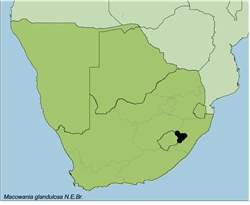Names and synonyms
Macowania glandulosa N.E. Br.
Type
Evans 412, KwaZulu-Natal, on the top of Tabamhlope Mt, 1825-2135 m, Feb. (K, NH)
Derivation of names
Macowania = after Dr. Peter MacOwan (1830-1901), botanist, director of the Cape Town Botanic Gardens, and discoverer of new species at the Cape.
glandulosa = glandular, full of glands
Diagnostic characters
Leaves glandular -punctate
Corolla of disc florets glabrous
Anther tails of adjacent pairs cohering and smooth
Pappus of about 12 bristles slightly shorter than the corolla
Description
Dwarf, much-branched shrub forming low, hard, compact cushions up to 450 mm tall. Stems densely leafy when young, leaf scars prominent on older stems. Leaves imbricated, linear, up to 20 x 2-5 mm, acute, margins strongly revolute, lower surface white woolly but exposing the midrib, upper glabrous, glandular punctate, furrowed along midrib, rarely with stalked glands on the lower surface towards the base.Capitula sessile, solitary at the branch tips. Involucre funnel-shaped, c. 12-14 x 12-15 mm, bracts pale brown or straw-coloured, often with a purple-brown patch on the midline towards the tips, outer surface covered with stalked glands. Ray florets yellow, female. Disc florets hermaphrodite, corolla narrowly cylindric below, widening gradually above, glabrous. Cypselas c. 3.5 mm long, fusiform, 10-ribbed, the ribs spaced, densely covered in golden-brown twin-hairs. Pappus bristles 12, barbed, a little shorter than the disc corolla, persistent.
Flowering time
Mainly from September to November, but also in April, May and August.
Distribution
Appears to be confined to the Cave Sandstone platforms of the KwaZulu-Natal Drakensberg from Hlolela near Mont aux Sources to Bushman's Nek on the Cape border, between 1830 and 2400 m above sea level.
Known from more than 10 specimens.
Habitat
Appears to be confined to crevices of cave sandstone outcrops in the Drakensberg and rock sheets and large outcrops or fallen boulders.
Notes
Its glandular -punctate leaves make it the most easily recognised species.
References
ANDERBERG, A.A. 1991. Taxonomy and phylogeny of the tribe Gnaphalieae (Asteraceae). Opera Botanica 104: 50-53.
BROWN, N.E. 1901. Bulletin of Miscellaneous Information. Kew Bulletin 175-177: 124.
GLEN, H.F. 2004. SAPPI, What's in a Name? The Meanings of the Botanical Names of Trees. Jacana.
HILLIARD, O.M. & BURTT, B.L. 1976. Notes on some plants of southern Africa chiefly from Natal: V. Notes from the Royal Botanic Garden Edinburgh 34,3: 260-276.
HILLIARD, O.M. 1977. Compositae in Natal. University of Natal Press.
KESTING, D. & CLARKE, H. 2008. Botanical names, what they mean. Wild Flowers of the Cape Peninsula, 3rd revised edition. Friends of Silvermine.
POOLEY, E. 2003. Mountain Flowers. A Field guide to the Flora of the Drakensberg and Lesotho. The Flora Publications Trust.
SMITH, C. A. 1927. The genus Macowania, Oliv. Bothalia 2:348-350.
